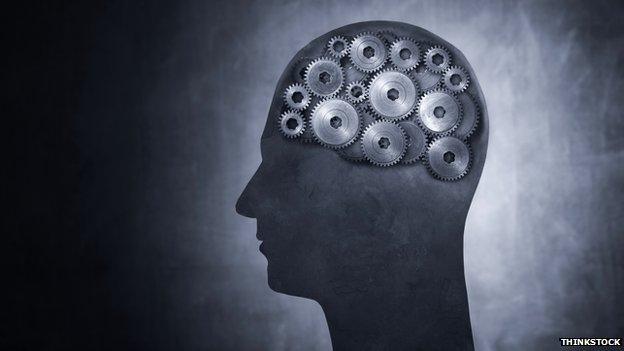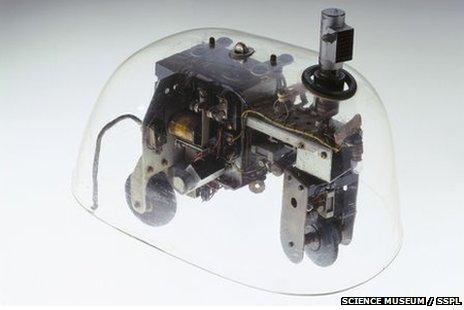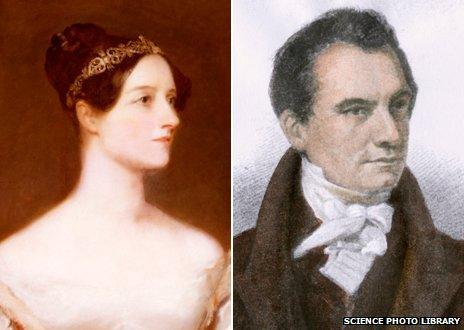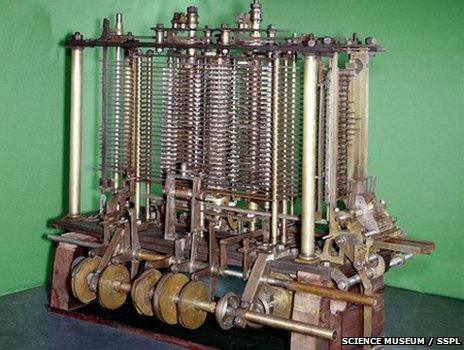A Point of View: Will machines ever be able to think?
- Published

The pursuit of artificial intelligence has long interested computer scientists, but will machines ever think for themselves, asks Lisa Jardine.
In the early 1950s, "machine intelligence" was a favourite topic among those who wanted to put the war years behind them and look forward to a sparkling science-led future.
From robots to electronic brains, the idea was that human beings would be able to concentrate on useful work, while programmable machines took care of useless toil. That unrealised dream still intrigues us today.
In April 1951 I was taken by my parents on an outing to the Bristol laboratory of neuroscience professor William Grey Walter, to see his robotic tortoises.
In a large room, half a dozen domed mechanised devices on wheels (roughly resembling tortoises) twirled and gyrated, avoided obstacles, backed away from the edges of their enclosure, and trundled apparently purposefully towards a light source beamed in their direction.

William Grey Walter's cybernetic tortoise
These, Grey Walter maintained, were the beginnings of artificial intelligence - machines which simulated human thought and behaviour using analogue electronics to mimic brain processes. I remember the grown-ups were delighted.
Back then, aged seven, I was a bit disappointed. These weren't "toys" in any sense that I understood. But the memory of the visit flooded back last weekend when I encountered a piece of archive film of the tortoises in the Codebreaker exhibition at London's Science Museum, external.
Codebreaker charts the life and legacy of the troubled mathematician Alan Turing, best known for his crucial work on the Bombe electro-magnetical device, used to crack the code created by German Enigma machines during WWII.
The exhibition includes the story of Bletchley Park, and the top secret cryptographical work Turing and others carried out there, which made such a vital contribution to the Allied victory. But it also explains a wide range of other work on early computers and machine intelligence.
The Grey Walter tortoises feature as an early example of a complex machine which appears to replicate human behaviour - in other words, to think.
Turing's own contributions to mathematics, and in particular to the theory behind early computers and computing went far beyond his wartime activities. Before he was recruited to the Government Code and Cypher School at Bletchley Park in 1938 he had been working on the idea of a machine which could be programmed to carry out many different mathematical operations or tasks - the precursor for the electronic data processors we take for granted today.
After the war Turing returned to this topic, and in 1950 published a paper entitled Computing Machinery and Intelligence, external, which is still cited today. In it, he speculates on what it would take for a computer to be considered to have gone beyond performing human-programmed tasks to become a "thinking machine".
"I propose to consider the question," his paper begins, "Can machines think?"
Arguing that they can, Turing chooses to engage directly with a computing pioneer of a century earlier who had given consideration to the question but reached the opposite conclusion - Ada King, Countess of Lovelace, or Ada Lovelace as she is generally known today.

Ada Lovelace and Charles Babbage
This week we celebrated Ada Lovelace day - an occasion on which we honour Lovelace herself and all other women working in what today are known as the STEM subjects (science, technology, engineering and mathematics). So let me say a little more about her before I get on to Turing's interest in her argument about machine intelligence.
Lovelace was born in 1815, the only legitimate daughter of Lord Byron. Privately educated in science and mathematics, her mother was determined she should not become a poet like her father. She is acknowledged to be an important contributor to the early development of the computer and computer programming.
Aged 17, Lovelace met Charles Babbage, conceiver of the Analytical Engine and regarded as the father of computing. His engine was never actually built, but is nevertheless generally recognised as the abstract precursor to a "universal machine" - one which can be programmed to perform a potentially infinite range of human tasks. Lovelace immersed herself in understanding the potential of the Analytical Engine. In the process she became possibly a clearer and more incisive exponent of it than Babbage himself.
In 1842, at Babbage's request, Lovelace translated an Italian article discussing the potential of the Analytical Engine.

She added a series of discussions of her own, explaining the possibilities for the engine and offering further explanation in considerable mathematical detail. These notes were approved by Babbage before publication, but Lovelace insisted on retaining total control.
In late July 1842, for instance, she writes: "I am much annoyed at your having altered my note. You know I am always willing to make any required alterations myself, but that I cannot endure another person to meddle with my sentences."
It is to these notes that Turing is referring a century later in his 1950 article. In one of them Lovelace says: "It is desirable to guard against the possibility of exaggerated ideas that might arise as to the powers of the Analytical Engine. The Analytical Engine has no pretensions whatever to originate anything. It can do whatever we know how to order it to perform. It can follow analysis, but it has no power of anticipating any analytical relations or truths."
We do not know how Turing came across Lovelace's notes. But he devotes a significant portion of his 1950 paper to countering what he calls "Lady Lovelace's objection" and he quotes her verbatim.
Her objection, he proposes, is tantamount to saying that "computers can never take us by surprise". Indeed they can, he counters. He believes Lovelace was misled into thinking the contrary because she could have had no idea of the enormous speed and storage capacity of modern computers, making them a match for that of the human brain, and thus, like the brain, capable of processing their stored information to arrive at sometimes "surprising" conclusions.
Probably the easiest way to understand what Turing had in mind is to think of the Google search engine. Initially it amazed us simply with its ability to search apparently instantaneously through every word currently on the world wide web. Now you can watch as you type, as it rapidly scans every search it has ever processed, to anticipate what you are looking for and suggest to you the question you might be just about to ask.
However Turing came to read Lovelace's notes on the Analytical Engine, he considered her important enough to engage with in print. I like to think that he recognised her as a kindred spirit. She was a mathematically precocious woman, considered scandalous for her unashamed desire to engage in intellectual debate on equal terms with men.
Turing was an introverted, mathematically gifted boy whose open homosexuality made his life extremely difficult, and who committed suicide in his early 40s. For both, understanding the intricate mechanisms of the mind was a goal to be pursued tirelessly and passionately, while the trials of the body were as far as possible set aside and ignored.
Their encounter does help us to understand the magnitude of Lovelace's achievement. When Turing argued that machines would eventually be able to think, he had in front of him at Manchester University a truly programmable machine, the precursor to the Atlas computer - Britain's first "super-computer".
Lovelace by contrast had only the idea of a computer on which to base her equally clear conviction that machines would only ever be able to do what we asked them to. Sixty years after Turing's death, when our mobile phone has 1000 times the speed and memory capacity of the Atlas computer, she has not yet been proved wrong and personally, I'm with Lovelace.
But let me end with Turing. In August 1951 he and four friends visited the Festival of Britain in London - that "tonic to the nation" devised by the Labour government to foster British pride and optimism for the future. In the festival's science exhibit in South Kensington they spent some time watching Grey Walter's tortoises. They were not particularly impressed - the tortoises seemed to spend most of their time going round and round in circles - although they did like the way the tortoises responded to their own reflections in a mirror.
But this wasn't much fun. They quickly abandoned South Kensington, and went instead to the festival funfair in Battersea where they thoroughly enjoyed themselves. It was one of the few happy occasions in the last years of Turing's life of which we have a record.
Follow @BBCNewsMagazine, external on Twitter and on Facebook, external